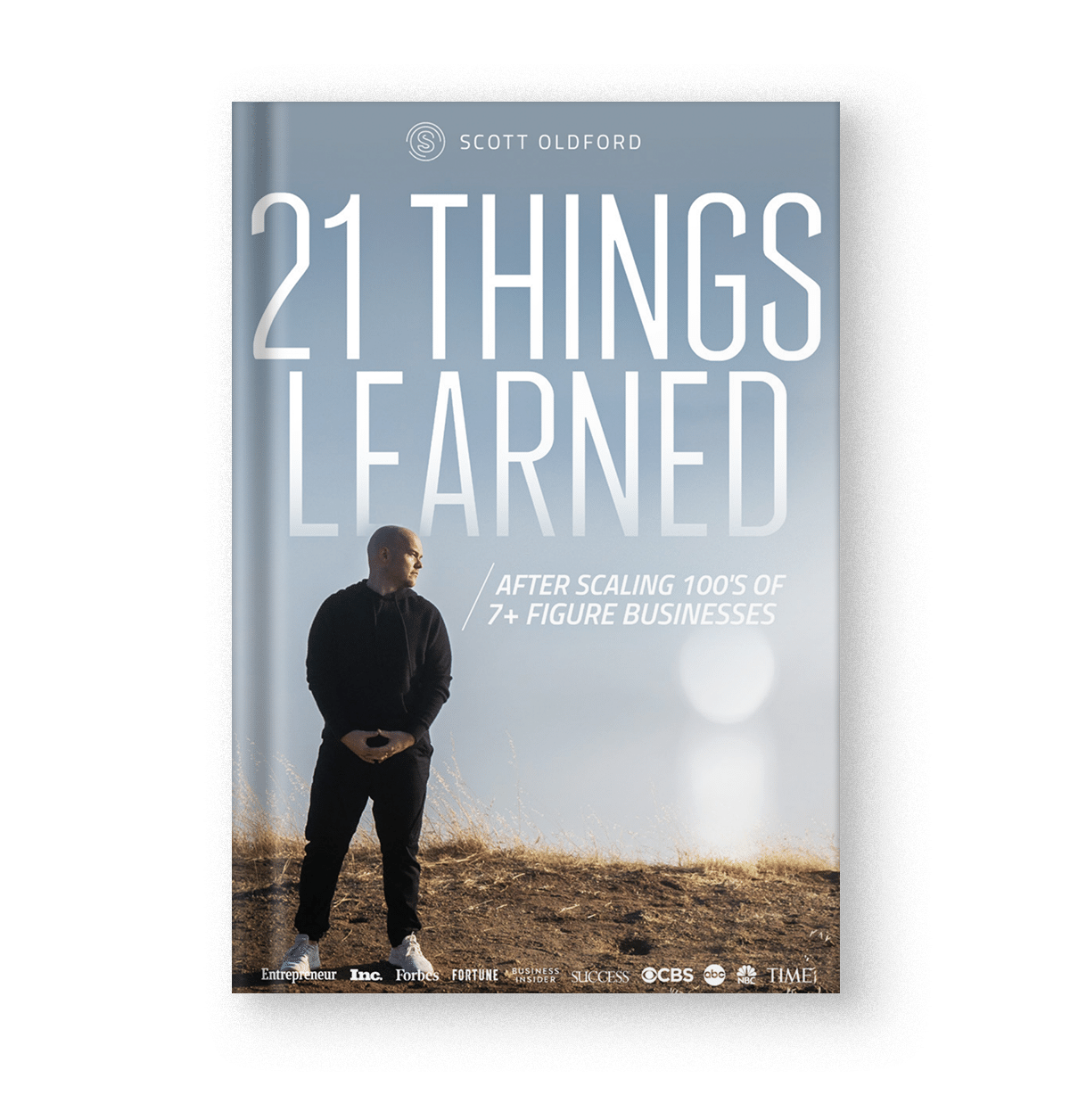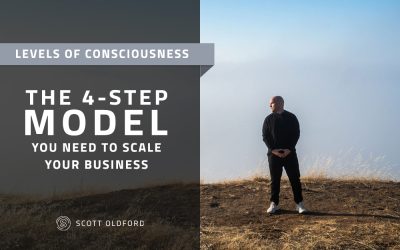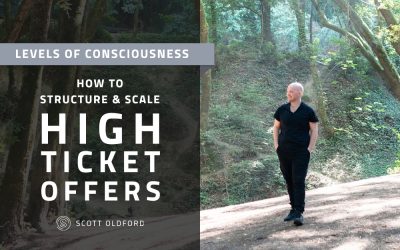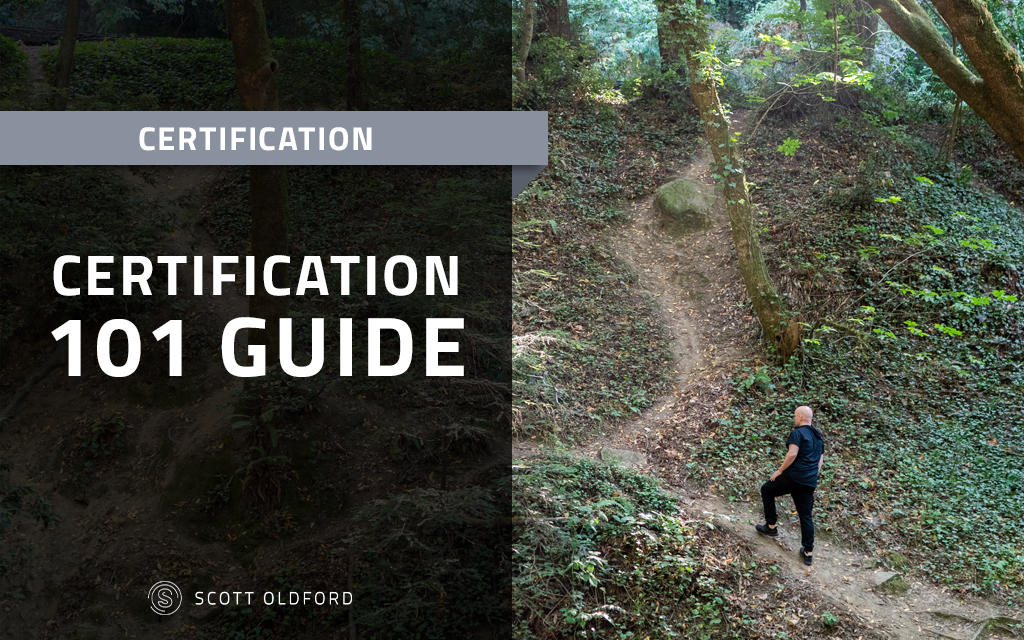
You may have noticed many entrepreneurs talk about certification businesses of late, and wondering if this is the next “big thing” you need to explore.
The answer to that is a bit of a yes and a no…
Certification businesses are building steam and have a very big reason why (more on that soon).
BUT they aren’t for everyone. In fact, most people shouldn’t look to build one (yet).
I’ve had more and more people ask me about certification businesses recently, wondering how to build one and if now is the right time. So I thought I’d write this article—as well as record several videos—to give you what you need.
After reading this, you’ll know if a certification business is right for you.
… as well as the next steps you need to take.
Certification 101: My Story So Far
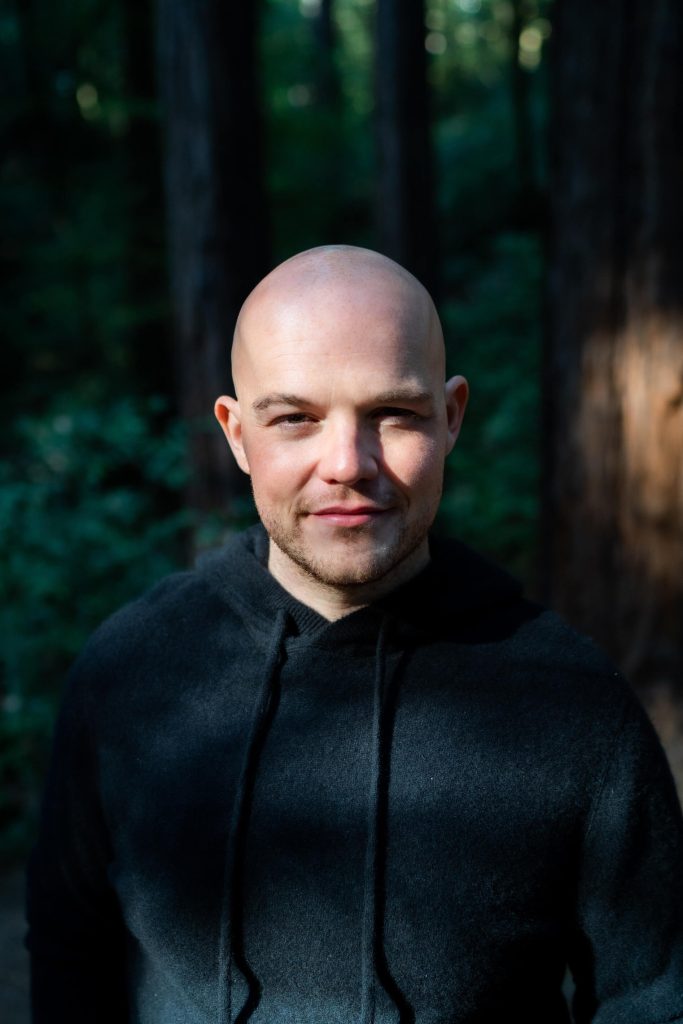
What is a certification business?
In many ways, it’s similar to any other online program.
This is how I used to see them…
In case you don’t know who I am, I’m Scott.
I’ve been an entrepreneur my whole life, and, as you’ll see by exploring my story, I’ve had a lot of ups and downs.
Today, I’m a business advisor and mentor, as well as someone who invests in other businesses/sectors that light me up.
One of these has centered around certifications, and let’s just say I’ve had my eyes opened in recent years.
For a long time, I assumed they were expensive group programs. And sure, there are similarities. But there are also some MASSIVE differences that are the reason I’m writing this.
The biggest surrounds EDUCATION.
As a whole, society has evolved a lot over the last few decades. Everything from technology to how we gather and perceive information, we no longer work nor learn in the same way we did a few generations ago. Yet the education system has basically remained the same.
Not just how we teach our younger generations, either, but college, university, and even adult learning.
When you take a step back, it’s easy to see how ridiculous it is.
Everything around us evolves, yet how we teach and learn remains the same?
Doesn’t make sense, right… This is why we’re seeing a huge boom in the eLearning space. It’s not only more accessible, but it provides educators and students alike to teach and learn in more efficient ways.
This is when my entire outlook on certification businesses changed.
In 2018, I found myself working with them more and more. I saw how they did things, and it gave me a glimpse into the future. It impacted how I created my own content and collaborated with my own community—to the point where I found myself investing in several of them in 2020.
(in fact, the majority of members in my accelerator program are involved in some kind of certification)
How certification businesses differ from standard programs is that they combine these key elements…
Education + Reality Creation + Transformation
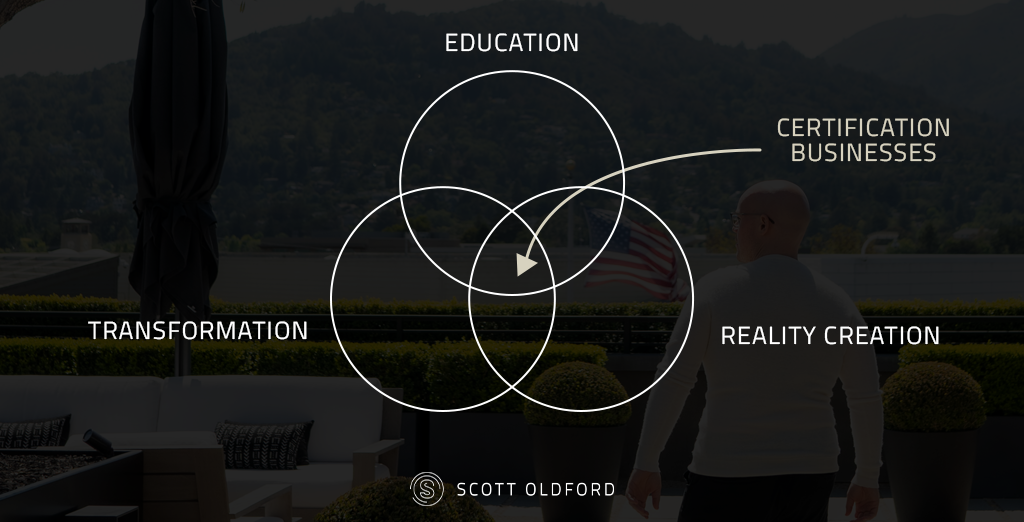
As I say, our relationship with education is changing. It NEEDS to change. What worked in the past no longer does. Whether you’re planning your future or in the middle of your career, it often doesn’t make sense to go to a single institution for four years to learn about this and that.
You need the freedom to learn where and when you want to.
Not from general practitioners, but specific subject experts!
This is where reality creation comes in…
A real, defined subject expert knows how to give you what you need when you need it. No more four years of learning, just to end up with a general perspective. Instead, you’re given a specific skill set that allows you to change your reality in the here and now.
Whether you’re seventeen years of age or fifty-seven, this is valuable!
Finally, certification businesses provide transformation. Not just to you as a creator, but to your students. More so, it gives your members a chance to transform the lives of those they serve. It isn’t knowledge for knowledge’s sake. It’s specific. It is relevant.
As you’ll see throughout this guide, much of this looks similar to any other group program.
Yet the way you deliver it—and the driving force behind this—differs massively!
But the reality is, you may not be ready for this just yet. So before we go further, let’s see if you are!
WHO this is for…
- Are you a true expert in your subject?
- Do you already have a successful business?
- Are you ready and committed to playing the long game?
- Are you focused on customer transformation?
- Are you at a stage to make a real, lasting impact?
If you cannot answer “yes” to these five questions, a certification business isn’t for you.
In the beginning, I assumed this was just another line of revenue for your existing business.
Far from it…
In my experience, this becomes a new business in its own right, complete with its own team, strategy, and vision. It ideally aligns with your existing business. Yet you need to approach it as a unique entity.
For this reason alone, you need to be ready!
You need the money and leverage to properly focus on this. You need to have the luxury of not needing results right now. This takes time. Trust me, this entire process focuses on the long game.
True transformation for those you serve… but true transformation for yourself, too!
It’s all about impact. It is all about going a mile deep.
And as I’ve talked about in previous guides, there are five levels of desire you go through.
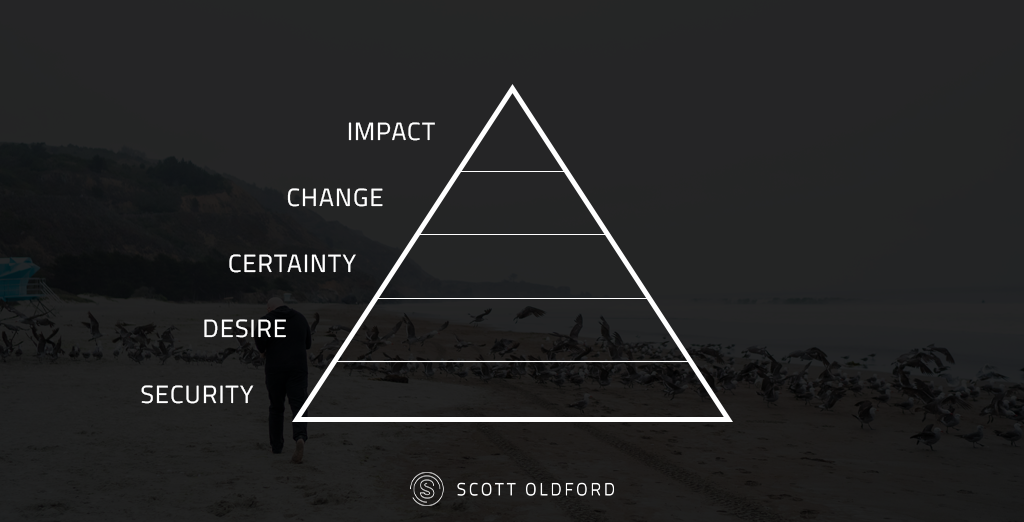
If you’re in level 1 (security), level 2 (desire), or level 3 (certainty)… a certification business isn’t what you need. Whereas if you’re in level 4 (change), or, ideally level 5 (impact), this may be for you.
Because in levels four and five, your focus and vision shift.
You don’t care only about right now and how much money you can make.
In these stages, your relationship with money changes!
You go from focusing on how you can impact your life to how you can better impact your community, industry, and the world at large. This is when you reap the benefits of a certification business.
Better yet, it’s when those you serve reap the real benefits on offer.
So let’s dive deeper into this and tackle the five stages you need to go through. But don’t just read what comes next. Take notes. Reflect throughout and relate it to your situation. Make a commitment to implement what’s on offer.
Stage 1: Planning
This whole process begins with a detailed and thorough planning stage.
There are a few goals at play here, where you figure out:
- What your program looks like
- Who your ideal member is
- Whether this is actually what you need right now!
At this stage, you’re likely unsure if this is the right time for a certification business.
So to start with, create a new document and answer these questions:
- Is this right for you… do you have the right intentions for this program?
- Whats’ your end goal… why do you want to create it?
- Do you have what’s required to support all this… energy, money, time, team?
Once more, this isn’t a quick process. In my experience, you can expect two to three years before you start to make any significant profit. As such, this is best done when times are already good.
If you don’t have that situation or your goals center around quick results, this isn’t for you (yet).
Beyond this, you have to figure out WHO you’re building it for.
In that same doc, answer:
- Who needs this program and why do they need it?
- What do they need to learn/experience for it to be of value?
- What will this allow them to achieve that they cannot do so already?
- What support do they need both in the short and long term?
As important as it is for you to do this for the right reasons, you need members who do the same. If they’re expecting instant results, they’re not a good fit.
Finally, you need to structure your entire program before you make a commitment to creating it. You don’t need all the answers, but you do need enough to form a clear picture for both you and those you serve.
In that same document, make notes on the following sections:
1: Level of Learning:
Your job with a program like this is to give your members what they need. Not so much that it overwhelms them or takes up more of their time than necessary. But not so little that it only helps them move the needle a little.
You need to provide just the right amount of depth.
Your task here is to think about what this looks like and the type of material you’ll provide: lessons, resources, coaching, etc…
2: Level of Support:
It’s not just about what you teach, but how you support your members. You need to give them what they need. Not calls or coaching for the sake of it. But also not too little that they’re left wanting.
You need to step up and provide the support they need.
3: Length of Program:
The length of your program also plays a role. Again, too long is no good. But too short isn’t, either.
Under the assumption you deal with busy members that already lead a busy life, you cannot expect too much. The question you need to ask is: what’s the minimum amount of time (and commitment) I need from them to achieve what they need?
This differs from situation to situation. What matters is you take the time to think about this now.
4: Type of Review:
Something else a program like this needs is feedback.
Maybe this comes from you. Maybe from specific coaches or subject matter experts. Maybe it happens online or via coaching calls. Maybe you need to provide an in-person experience…
As before, you need to provide a level here that makes sense to your members. Not too much, but not too little. Everything you offer has to have a purpose and provide massive value.
5: Planning & Payment:
Once you hone in on all this, you begin to form a picture of how much it should cost.
Not just in a literal sense, but the type of time and energy it requires. A mistake I often see is how someone has an ideal price in mind and tries to fit their program around this.
Big mistake.
Focus on the value your ideal member needs. Provide the service they need, and then build your price around this. If it comes out higher than expected, get creative with payment plans and financing offers.
6: “Success” Criteria:
Finally, you need to get clear on what success looks like and what someone achieves at the end of this program. In time, you may get your certification accredited, offering your members greater value.
Yet even before this, you can ensure you give your members something.
… something that proves they’ve done the work.
… and something you can measure to ensure they are where they need to be!
The question for you is: what does this look like? what does it involve?
At the end of this initial stage, you’re left with an “overview” doc that gives you a clear insight into who your ideal members are, what your program involves, and whether this is right for you.
Do not commit before you reach this point.
Keep an open mind and do the work!
If it still makes sense here, move on. If not, don’t go any further. A certification business is a great opportunity, but only if the time and situation are right. If it is, use this time to map out your program in greater detail and create an outline of your curriculum.
You don’t need all the answers here. But the more clarity you have, the better.
Stage 2: Launch
If you reach this point and decide you’re ready, it’s time to run an initial, mini launch.
At this stage, you need to keep it low-key.
This isn’t the time to run ads, partnerships, or joint ventures. For this launch, only present it to your existing audience (and look to build an initial group of 20-50 people).
50 is your max… the point with this initial group is to build your program as you go on.
Too many members make it harder to achieve this.
Whereas too little makes it difficult to validate your offer.
Depending on your program, you’ll work with these people for 3-12 months. Again, this is a long burn. If you’re expecting to scale within a few months, THIS IS NOT for you!
So… what does your initial mini launch look like? You’ll want to:
- Promote it to a warm audience that already knows and trust you
- Run a short launch that lasts only 7-14 days
- Include some kind of direct messaging, like a webinar or virtual event
- Get leads on the phone to speak to them (not just sell, but learn about who they are)
- Offer a discounted price and make it clear you’re building this as you go on
- Use retargeting ads only (no ads to a cold audience)
- Be hyper-focused on qualifying every single member (they have to be the right fit!!)
Your main aim here is quality, not quantity. It’s better to have twenty fully-committed members than onboarding an extra ten who aren’t. All this does is dilute the impact of your program.
Remember, you have no social proof at this stage. You don’t even have a program.
Success depends on what you produce with this initial group.
The more aligned they are, the better.
Use this mini launch as a time to get your messaging on-point, hone in on your offer and pricing, get to know your audience and what their problem/pain is, and build trust, relevance, and intimacy.
Stage 3: Build The Backend
Once you launch and onboard your initial group of members, it’s time to get to work.
Ideally, you want to give yourself at least one month between the end of the launch and when you begin.
This gives you the time to create one to two months of program material ahead of time. Now, in general, you don’t want to pre-build this program in advance. You’ll learn so much while working with this first group that anything you build WILL change.
Saying that, it is important you give your members something to work with from the beginning.
As well as giving you a little breathing space…
Once you start the program, you’ll want to:
- Record Live Sessions: at least one or two of these each week
- Run Regular Q&As: to not only add value but to learn and observe
- Add Material as Needed: based on questions and feedback, create what you need to
Remember, this isn’t a standard course or program. Your focus here is to transform your members, which needs a lot more depth: workbooks… exercises… blueprints… challenges… review sessions… you need to go deep!
The problem is, you won’t know what this involves until you dive in. This is why those live sessions and Q&As are so important. You get a chance to not only teach your members but to learn from them. As you go along, build what they need. It’s very much a tailored and fluid process.
… which is why the less you build in advance, the better!
To help you do all this, you will need a small team. In my experience, the essential roles are:
- an Eduction Developer (someone to build the various material and coordinate everything)
- a Coach (one coach for every twenty-five members)
Having these two roles not only saves you time but allows you to better serve your members. As well as the regular live sessions and Q&As, for example, your coach(es) offer additional calls and drop-in sessions. This not only provides a better service but teaches you more about who you serve
… and what they need!
So don’t try and do all this yourself. Build a small team and make a commitment to provide the best service you can. Don’t obsess over perfection. Don’t pre-build and create a long runway. You need to stay flexible and ready to adapt. But do go deep and prepare yourself (and team) to pivot when necessary.
Stage 4: Build The Front-End
As well as building the backend, you also have to focus on the front end.
And the way to market, promote, and scale a certification business isn’t the same as most other online businesses…
When we look at a normal front end, it centers around:
Pain → Problem → Process → Method → Proof → Belief → Vision
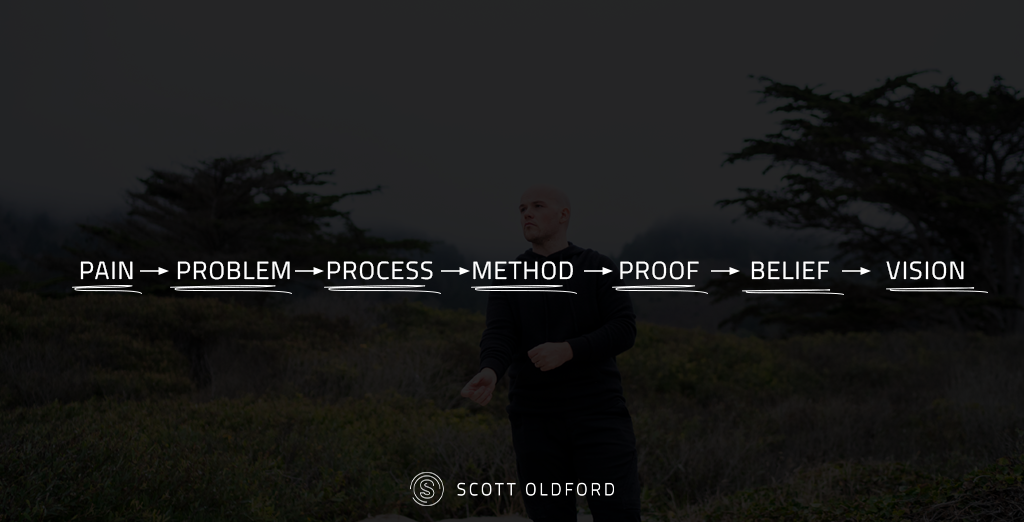
In a relatively short period of time, you “sell” to a cold audience and then nurture them down the road, upselling and cross-selling where necessary.
This doesn’t work with a certification business!
The costs are just too high—with profit margins of 20-30% at best!
This is why—once again—I want to make it clear a certification business isn’t a quick fix or something you want to take on while still building momentum.
So, how do you promote your certification to your audience?
I’ve found it’s best to see it as an add-on—like you would with any other high-ticket offer. But rather than it being a product in your existing business, this product becomes its own business.
The key here is to ensure your existing (main) business and certification business aligns.
It needs to be a natural progression for your audience as you earn their trust.
Here’s what the process looks like…
Slow Lane ⇒ Fast Lane ⇒ Low-Cost Offer ⇒ Nurture Audience ⇒ WaitList ⇒ Certification Launch
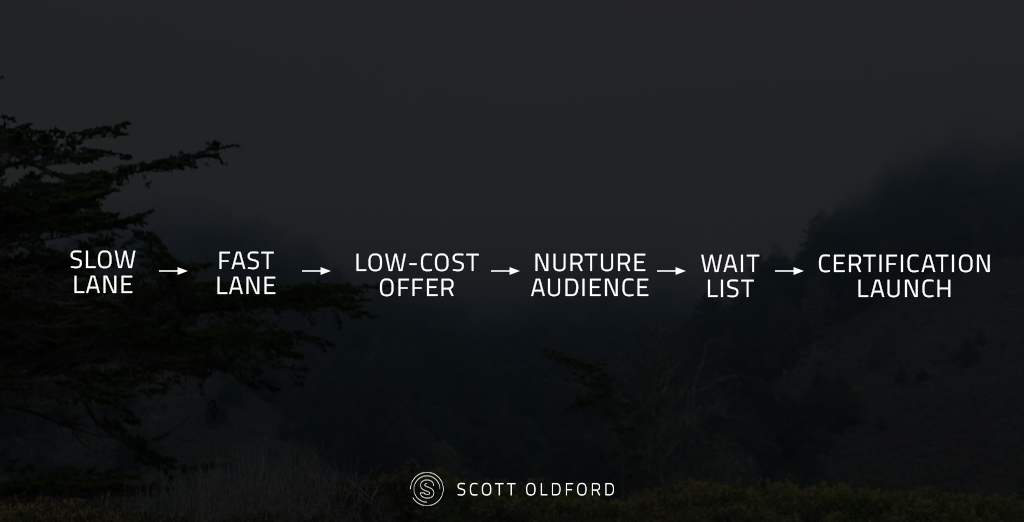
The first few steps (Slow Lane + Fast Lane + Lower-Ticket Item) take place in your existing business. This is where you generate affordable leads and turn them into customers.
This is also where they learn about you and your business and then develop trust and intimacy.
The “Nurture Audience” step is the bridge between your main business and new certification. It’s where you utilize tactics from The R.O.I. Method to become a trusted source. From here, you introduce them to your certification program and explain what it’s all about.
(using the standard structure of Pain → Problem → Process —> and so on…)
But rather than “sell” to them straight away, you have them join a Waitlist. In my experience, this is a key step you don’t want to skip. For starters, an evergreen certification business is tough to maintain. It’s better to run regular cohorts and offer spaces to those inside your waitlist.
Beyond this, you’ll find some people remain inside your waitlist for a few rotations before they’re ready to pull the trigger. Timing is so important, for you and for them.
This is why having an existing, successful business is important.
It’s also why having existing trust, rapport, and intimacy with your audience matters.
It’s this main business that provides fuel for your certification program.
So although a lot of the front-end marketing may look the same for a certification program, the way you go about this is unique. You need to use your existing business as a glorified lead generation tool.
You need to create waitlists to better nurture and warm people up!
If you achieve this, you’re in a position to scale and reap the long-term rewards.
Stage 5: Scale
All this takes two to three years to get going and build momentum.
It’s a sow burner, but once it begins to burn it can take on a life of its own.
The question is, how do you know when it’s time to scale?
There’s no easy answer to that. It depends on your situation: how much capacity you have to take on new members/launch new cohorts, how much money and other resources you have to invest, how many people you work with and how much social proof you’ve built…
After running several cohorts and going through this process a few times, this becomes clearer.
Those first few rotations are all about:
- Tightening up the whole process (from the material on offer to the systems driving them)
- Building a waitlist and developing social proof
This is why I encourage most of my clients to continue to focus on their main business during this time.
The larger this grows, the larger the audience your certification program has access to. So long as you nurture your people and build a bridge between your main business and certification (ie: your waitlist) you set yourself up for success down the road.
So, during this time, don’t worry about scaling your program.
Instead, focus on making it better. Get your messaging right. Gather social proof and testimonials. Build trust and intimacy. Don’t rush the process and try to take on too many members (or launch too many cohorts)! Don’t build your team and throw too much money and resources at operations!
Just focus on growing your main business and tightening up your certification.
If you do this, you reach a point—two to three years in—where you’re ready to scale up.
A good sign is usually when you not only have a constant flow of leads into your waitlist, but you keep having to turn people away each time you launch a new cohort.
This is when you need to consider growing your team, bringing in new members, launching more frequently, etc…
Yet the real value of scaling a certification business comes when you create a few add-ons:
- Continued support that extends beyond the initial program period…
- A second phase to the certification experience…
- In-person events and more intimate support…
In time, you can even become a matchmaker where you pair your clients with those who have gone through your certification program.
It’s here you increase your profit margins and start to make some real money.
This is also the period when other businesses likely show interest, from competitors to traditional educational organizations/institutes. If you have plans to exit your business in the future, this is when it gets VERY exciting for you.
BUT REMEMBER… THIS TAKES TIME!
I don’t want to sound like a broken record, but it’s important to appreciate none of this “just” happens.
- You’ll spend 3-6 months planning all this and getting organized
- You will then spend another 3-6 months launching your first cohort
- It then takes at least 18 months before you can make any money out of the business
- And another 2-3 years before it becomes self-sustainable
In total, you’re looking at two years (at least!!) before you have anything to show for your hard work—and pushing on five years before you reap the long-term rewards.
This is why it’s important to have an already successful business with momentum behind it.
It’s not only that which fuels your certification program, but it gives you the necessary resources.
There are no shortcuts to this.
It takes time. It takes commitment.
But as you can see, the benefits on offer are huge!
Certifications Conclusions & Next Steps
We began this guide by asking if building a certification business is right for you?
Having read this, you should now know.
It’s a big leap to take, and it’s one you have to be ready for (you and your team). Yet the benefits on the other side are huge—especially if you have ambitions of exiting your business in the next decade.
The entire educational industry is changing, and there are some big shifts ahead.
Now is a good time to think about certifications…
There are some massive opportunities, which I’ve seen for myself—through my own business and after working with multiple clients and students.
If you’re interested in taking that next step, I’d love to explore this with you.
I have experience going through this process multiple times (and across many sectors). This guide only scratches the surface, visit this page to know more about how I help businesses build/scale their certification business.

